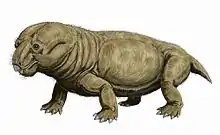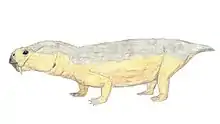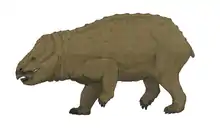Dicynodontoidea
Dicynodontoidea is an infraorder of dicynodont therapsids that includes the famous dicynodont Dicynodon, Lystrosaurus and the Triassic Kannemeyeriiformes, as well as numerous other closely related species. The name was coined by American paleontologist Everett C. Olson in 1941 as an infraorder, despite using the typical "-oidea" suffix of superfamilies, and was later redefined under a phylogenetic context in 2009 by paleontologist Christian F. Kammerer.[1][2]
| Dicynodontoidea Temporal range: Late Permian - Late Triassic | |
|---|---|
 | |
| Life restoration of Vivaxosaurus | |
| Scientific classification | |
| Kingdom: | Animalia |
| Phylum: | Chordata |
| Clade: | Therapsida |
| Clade: | †Dicynodontia |
| Clade: | †Bidentalia |
| Infraorder: | †Dicynodontoidea Olson, 1941 |
| Subgroups | |
References
- Kammerer, C.F.; Angielczyk, K.D. (2009). "A proposed higher taxonomy of anomodont therapsids" (PDF). Zootaxa. 2018: 1–24.
- Christian F. Kammerer (2019). "Revision of the Tanzanian dicynodont Dicynodon huenei (Therapsida: Anomodontia) from the Permian Usili Formation". PeerJ. 7: e7420. doi:10.7717/peerj.7420.
This article is issued from Wikipedia. The text is licensed under Creative Commons - Attribution - Sharealike. Additional terms may apply for the media files.






